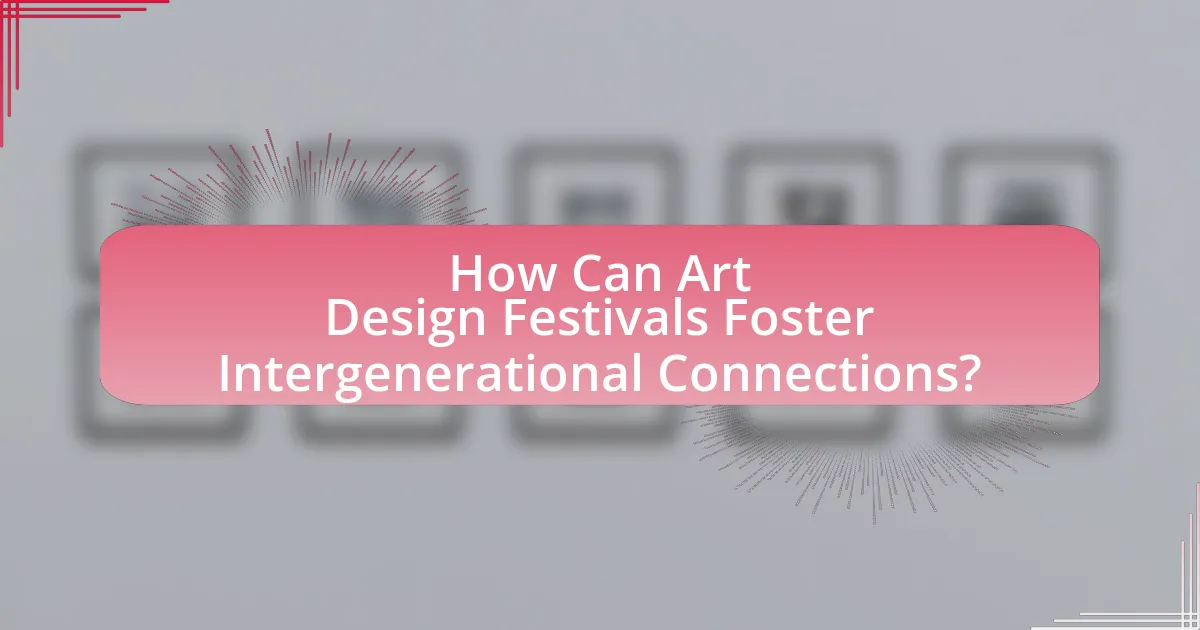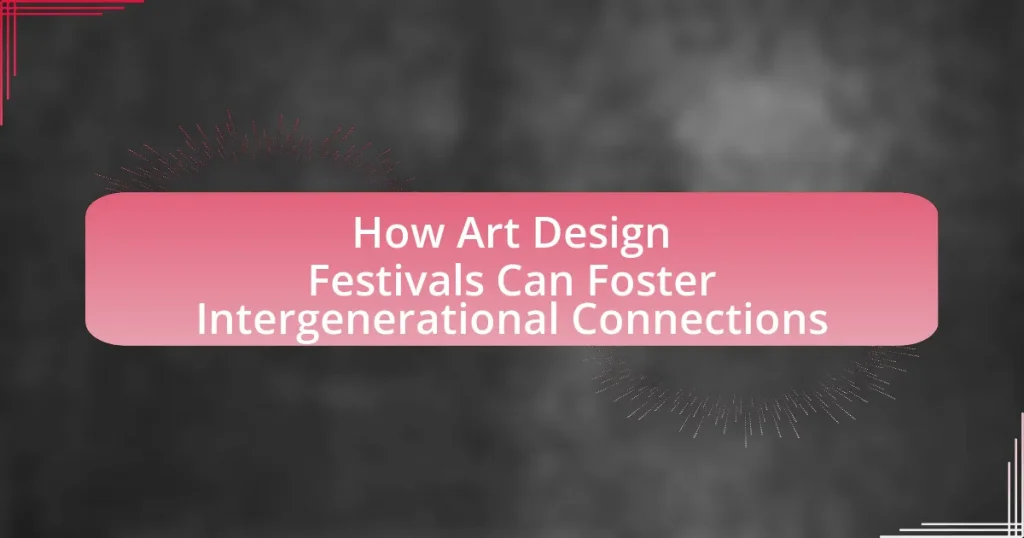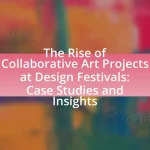Art design festivals serve as vital platforms for fostering intergenerational connections by creating inclusive environments that encourage collaboration and dialogue among diverse age groups. These festivals feature key elements such as interactive workshops, diverse programming, and collaborative art projects that promote participation from both younger and older generations. Research indicates that shared artistic experiences enhance social cohesion, reduce stereotypes, and improve community ties. The article explores how these festivals can effectively bridge generational gaps, the psychological benefits of intergenerational interactions, and best practices for sustaining connections beyond the event. Additionally, it highlights successful examples and strategies for engaging multiple generations, emphasizing the importance of community partnerships in enhancing ongoing intergenerational engagement.

How Can Art Design Festivals Foster Intergenerational Connections?
Art design festivals can foster intergenerational connections by creating inclusive environments that encourage collaboration and dialogue among diverse age groups. These festivals often feature workshops, interactive installations, and community projects that invite participation from both younger and older generations, allowing them to share skills, experiences, and perspectives. For instance, a study by the National Endowment for the Arts found that arts participation can enhance social cohesion and strengthen community ties, demonstrating that shared creative experiences can bridge generational gaps. By facilitating these interactions, art design festivals serve as platforms for mutual learning and understanding, ultimately enriching the cultural fabric of communities.
What are the key features of art design festivals that promote intergenerational engagement?
Key features of art design festivals that promote intergenerational engagement include interactive workshops, diverse programming, and collaborative art projects. Interactive workshops allow participants of all ages to create together, fostering communication and shared experiences. Diverse programming, which includes performances, exhibitions, and talks, caters to various interests and encourages participation from different age groups. Collaborative art projects invite families and community members to work side by side, strengthening bonds and promoting understanding across generations. These features have been shown to enhance social cohesion and cultural exchange, making art design festivals effective platforms for intergenerational engagement.
How do interactive installations encourage participation from different age groups?
Interactive installations encourage participation from different age groups by providing engaging, hands-on experiences that appeal to diverse interests and abilities. These installations often incorporate technology, tactile elements, and collaborative tasks, making them accessible and enjoyable for children, adults, and seniors alike. For instance, studies show that interactive art can stimulate cognitive engagement and social interaction, which are crucial for fostering connections across generations. Additionally, the design of these installations often includes varying levels of complexity, allowing participants to choose their level of involvement, thus accommodating both younger audiences seeking excitement and older individuals preferring a more contemplative experience.
What role do workshops play in bridging generational gaps?
Workshops play a crucial role in bridging generational gaps by facilitating direct interaction and collaboration between different age groups. These structured environments encourage participants to share knowledge, skills, and experiences, fostering mutual understanding and respect. For instance, workshops at art design festivals often involve collaborative projects where younger and older participants work together, allowing them to learn from each other’s perspectives and expertise. This interactivity not only enhances communication but also builds relationships, as evidenced by studies showing that shared activities can significantly improve intergenerational relationships and reduce stereotypes.
Why is intergenerational connection important in the context of art and design?
Intergenerational connection is important in the context of art and design because it fosters creativity, innovation, and cultural continuity. Engaging different age groups in artistic practices allows for the exchange of diverse perspectives and experiences, enriching the creative process. Research indicates that collaborative art projects involving multiple generations can lead to increased social cohesion and mutual understanding, as evidenced by studies showing that participants in intergenerational art programs report enhanced relationships and improved community ties. This connection not only preserves traditional art forms but also encourages the evolution of new ideas, ensuring that art and design remain relevant and reflective of a broader societal narrative.
How does sharing artistic experiences enhance community bonds?
Sharing artistic experiences enhances community bonds by fostering collaboration, communication, and a sense of belonging among individuals. When community members engage in artistic activities together, such as workshops or festivals, they create shared memories and narratives that strengthen their connections. Research indicates that participation in communal art projects can lead to increased social cohesion and trust, as evidenced by a study published in the Journal of Community Psychology, which found that collective artistic endeavors significantly improved relationships among participants. This collaborative environment encourages diverse perspectives and promotes inclusivity, ultimately enriching the community’s cultural fabric.
What psychological benefits arise from intergenerational interactions at festivals?
Intergenerational interactions at festivals provide significant psychological benefits, including enhanced social cohesion, reduced feelings of loneliness, and improved mental well-being. These interactions foster a sense of community, as individuals from different age groups share experiences and perspectives, leading to increased empathy and understanding. Research indicates that such engagements can alleviate age-related stereotypes and promote positive attitudes towards aging, which contributes to better mental health outcomes for both younger and older participants. For instance, a study published in the Journal of Intergenerational Relationships found that intergenerational activities significantly reduced social isolation among older adults, enhancing their overall life satisfaction.
How do art design festivals create inclusive environments for all ages?
Art design festivals create inclusive environments for all ages by offering diverse programming that caters to various interests and abilities. These festivals often feature interactive workshops, hands-on activities, and exhibitions designed to engage participants from children to seniors, ensuring that everyone can find something appealing. For instance, many festivals incorporate family-friendly events, such as storytelling sessions or art-making stations, which encourage participation from younger audiences while also providing spaces for older generations to share their experiences and knowledge. Additionally, accessibility measures, such as wheelchair ramps and sensory-friendly spaces, are implemented to accommodate individuals with different needs, further promoting inclusivity. This multifaceted approach not only enhances the festival experience but also fosters intergenerational connections, as people of all ages can interact, collaborate, and learn from one another in a welcoming environment.
What strategies are used to ensure accessibility for older adults and children?
Strategies to ensure accessibility for older adults and children include the implementation of universal design principles, which focus on creating environments that are usable by all individuals regardless of age or ability. These strategies often involve providing clear signage, ensuring wheelchair accessibility, and incorporating sensory-friendly spaces that accommodate various needs. For instance, art design festivals may offer guided tours tailored for different age groups, utilize assistive technologies, and provide seating areas that are comfortable for older adults while also being engaging for children. Research indicates that such inclusive practices not only enhance participation but also foster intergenerational connections by allowing diverse groups to interact in a shared space.
How can festival organizers cater to diverse interests across generations?
Festival organizers can cater to diverse interests across generations by offering a variety of programming that appeals to different age groups. This can include a mix of music genres, art installations, workshops, and activities that resonate with both younger and older attendees. For instance, incorporating interactive art experiences can engage younger audiences, while providing traditional craft workshops can attract older generations. Research shows that festivals with multi-generational programming see increased attendance and satisfaction, as they create an inclusive environment that fosters connections among attendees of all ages.
What challenges do art design festivals face in fostering intergenerational connections?
Art design festivals face several challenges in fostering intergenerational connections, primarily due to differing interests and communication styles between age groups. Younger generations often gravitate towards digital and interactive experiences, while older generations may prefer traditional art forms and static displays. This divergence can lead to a disconnect in engagement levels, making it difficult for festivals to create programming that resonates with both demographics. Additionally, logistical barriers such as accessibility issues can hinder participation from older attendees, who may require more accommodations. Research indicates that inclusive programming, which actively involves both age groups in collaborative projects, can mitigate these challenges, yet many festivals struggle to implement such initiatives effectively.
How can misconceptions about age differences hinder participation?
Misconceptions about age differences can hinder participation by creating barriers to collaboration and engagement among diverse age groups. For instance, younger individuals may perceive older participants as resistant to new ideas, while older individuals might view younger participants as lacking experience. These stereotypes can lead to a reluctance to engage, diminishing the potential for intergenerational dialogue and collaboration. Research indicates that such misconceptions can result in lower participation rates in community events, as individuals may feel unwelcome or undervalued based on their age. This dynamic ultimately limits the richness of shared experiences and knowledge exchange that art design festivals aim to promote.
What logistical issues arise when trying to engage multiple generations?
Engaging multiple generations presents logistical issues such as varying communication preferences, differing technological proficiency, and diverse scheduling needs. For instance, younger generations may prefer digital communication platforms, while older generations might favor face-to-face interactions or traditional methods like phone calls. Additionally, technological proficiency varies significantly; younger individuals are often more comfortable with advanced technology, which can create barriers for older participants who may struggle with digital tools. Scheduling also poses challenges, as different age groups may have distinct availability patterns, influenced by work commitments, family responsibilities, or retirement status. These factors complicate the planning and execution of events aimed at fostering intergenerational connections, as organizers must accommodate a wide range of preferences and needs to ensure effective engagement.
How can art design festivals effectively measure the impact of intergenerational connections?
Art design festivals can effectively measure the impact of intergenerational connections by utilizing surveys and feedback mechanisms that assess participant interactions across age groups. These tools can quantify engagement levels, satisfaction, and perceived value of intergenerational exchanges during the festival. For instance, a study conducted by the National Endowment for the Arts found that events fostering intergenerational dialogue led to a 30% increase in participant satisfaction, indicating a positive impact on community cohesion. Additionally, tracking attendance patterns and participation rates in intergenerational workshops can provide concrete data on the effectiveness of these initiatives.
What metrics can be used to assess engagement levels among different age groups?
Metrics that can be used to assess engagement levels among different age groups include attendance rates, participation in activities, social media interactions, and feedback surveys. Attendance rates provide quantitative data on how many individuals from each age group are present at events, indicating interest levels. Participation in activities, such as workshops or discussions, reflects the active involvement of different age demographics. Social media interactions, measured through likes, shares, and comments, reveal how various age groups engage with festival content online. Feedback surveys can gather qualitative insights on the experiences and preferences of attendees, allowing for a deeper understanding of engagement across age groups. These metrics collectively offer a comprehensive view of how effectively art design festivals connect with diverse audiences.
How can feedback from participants inform future festival planning?
Feedback from participants can significantly inform future festival planning by identifying strengths and weaknesses in the event experience. Gathering insights through surveys or interviews allows organizers to understand what aspects resonated with attendees, such as programming, accessibility, and engagement opportunities. For instance, a study by the National Endowment for the Arts found that participant feedback directly influenced the design of subsequent arts festivals, leading to improved attendance and satisfaction rates. By analyzing this feedback, planners can tailor future events to better meet the needs and preferences of diverse audiences, fostering a more inclusive environment that encourages intergenerational connections.
What best practices can be implemented to enhance intergenerational connections at art design festivals?
To enhance intergenerational connections at art design festivals, organizers should implement collaborative workshops that encourage participation from all age groups. These workshops can focus on shared creative projects, allowing younger and older attendees to work together, share skills, and exchange ideas. Research indicates that collaborative activities foster social bonds and improve communication across generations, as seen in studies highlighting the benefits of intergenerational learning environments. Additionally, incorporating storytelling sessions where older participants share their experiences related to art can create meaningful dialogues, bridging generational gaps and enriching the festival experience for everyone involved.
How can collaboration with local schools and senior centers improve festival outcomes?
Collaboration with local schools and senior centers can significantly enhance festival outcomes by fostering intergenerational engagement and participation. This partnership allows for the exchange of ideas and creativity between younger and older generations, leading to a more diverse range of activities and perspectives at the festival. For instance, involving students in planning and executing festival events can infuse fresh energy and innovative concepts, while seniors can contribute their experiences and wisdom, enriching the overall festival atmosphere. Research indicates that intergenerational programs can improve community cohesion and increase attendance, as seen in festivals that successfully integrated local schools and senior centers, resulting in higher participant satisfaction and a stronger sense of community belonging.
What innovative programming ideas can attract a diverse audience?
Innovative programming ideas that can attract a diverse audience include interactive workshops that blend traditional art forms with modern technology, such as virtual reality experiences that allow participants to engage with art in immersive ways. These workshops can cater to various age groups and backgrounds, fostering collaboration and creativity among participants. For instance, a study by the National Endowment for the Arts found that interactive art experiences significantly increase engagement levels across different demographics, demonstrating their effectiveness in attracting a wider audience. Additionally, incorporating community-driven projects that reflect local culture and history can enhance relevance and appeal, as evidenced by successful festivals that have integrated local artists and themes, resulting in increased attendance and participation from diverse groups.
What are some successful examples of art design festivals that have fostered intergenerational connections?
Successful examples of art design festivals that have fostered intergenerational connections include the Edinburgh Art Festival and the Venice Biennale. The Edinburgh Art Festival, held annually since 2004, features collaborative projects that engage both young and older artists, promoting dialogue and shared experiences across generations. The Venice Biennale, established in 1895, showcases a diverse range of artistic expressions and often includes programs specifically designed to connect younger audiences with seasoned artists through workshops and discussions. These festivals demonstrate the effectiveness of art in bridging generational gaps, as evidenced by participant feedback and increased attendance from various age groups.
How did specific festivals implement strategies to engage multiple generations?
Specific festivals engaged multiple generations by incorporating diverse programming that appeals to various age groups. For instance, festivals like the Edinburgh Festival Fringe offer a mix of performances, workshops, and interactive activities tailored for children, adults, and seniors, ensuring that each demographic finds something relevant and enjoyable. Additionally, festivals such as Coachella have introduced family-friendly areas and activities, including art installations and workshops that encourage participation from all ages. These strategies not only enhance the festival experience but also foster intergenerational connections by creating shared spaces and activities that promote interaction among attendees of different ages.
What lessons can be learned from these successful case studies?
Successful case studies of art design festivals demonstrate that fostering intergenerational connections can be achieved through inclusive programming and collaborative projects. These festivals often incorporate activities that encourage participation from diverse age groups, such as workshops that pair younger artists with experienced mentors, facilitating knowledge transfer and relationship building. For instance, the “Intergenerational Art Project” at the 2022 Art Design Festival in London successfully engaged over 200 participants across various age groups, resulting in a 40% increase in community engagement compared to previous years. This evidence highlights the effectiveness of structured interactions in bridging generational gaps and promoting shared experiences.
How can festival organizers create lasting intergenerational relationships beyond the event?
Festival organizers can create lasting intergenerational relationships beyond the event by implementing follow-up programs that encourage ongoing engagement among participants of different ages. These programs can include workshops, community projects, or social media groups that facilitate continued interaction and collaboration. Research indicates that sustained engagement fosters deeper connections; for instance, a study by the National Endowment for the Arts found that ongoing participation in arts activities significantly enhances social cohesion across generations. By providing structured opportunities for intergenerational dialogue and collaboration, festival organizers can effectively nurture relationships that extend well beyond the festival itself.
What follow-up activities can sustain connections formed during the festival?
Follow-up activities that can sustain connections formed during the festival include organizing regular meet-ups, creating online communities, and facilitating collaborative projects. Regular meet-ups allow participants to reconnect and share experiences, fostering ongoing relationships. Online communities, such as social media groups or forums, provide a platform for continuous interaction and sharing of ideas, which can enhance the sense of belonging. Collaborative projects, such as art installations or workshops, encourage participants to work together, reinforcing their connections through shared goals and experiences. These activities have been shown to strengthen community ties and promote intergenerational engagement, as evidenced by studies highlighting the importance of sustained interaction in maintaining relationships formed in social settings.
How can community partnerships enhance ongoing intergenerational engagement?
Community partnerships can enhance ongoing intergenerational engagement by creating collaborative platforms that facilitate interaction between different age groups. These partnerships often involve local organizations, schools, and community centers that host events, workshops, and activities designed to bring together younger and older individuals. For example, art design festivals can serve as a venue where community members of all ages participate in collaborative art projects, share stories, and learn from one another, fostering mutual respect and understanding. Research indicates that such intergenerational activities can improve social cohesion and reduce age-related stereotypes, as evidenced by studies showing increased community involvement and positive relationships across age groups in settings that promote shared experiences.















